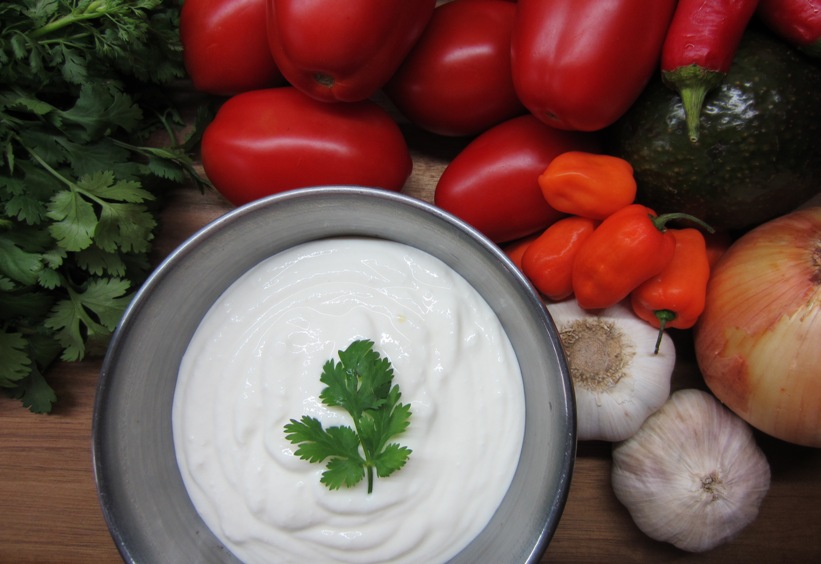When you hail from a hot climate, you’re going to end up with sour dairy. That’s how nature works. Thankfully sour doesn’t mean spoiled in many cases and clever food cultures have learned to embrace ambient heat and bacteria to give us all sorts of fabulous tastes from kefir to yogurt. The kitchens of Mexico are no different and their take on sour dairy is crema.
Saltier and almost pourable, it’s thinner than the American counterpart sour cream. Thinner even than its French cousin crème fraîche. Depending on the method and maturity, it compares to both on the tart spectrum or can have more zing than either. In any case, it’s everywhere on menus as a spoon-able shot of creamy, tangy richness. Saucy enchiladas get a topping as do tacos of most any make. It’s folded into gratins and finishes tortilla soup. Particularly tasty supercharged versions show up table side with additions like coriander leaf, sweet roast garlic, chipotle, toasted cumin seed, or fresh lime stirred into the mix. It’s the cool dairy equivalent of ubiquitous salsas and there are countless variations on the theme.
Up here in Canada having a painfully low inventory of local Mexican grocery stores (read that as “none”) from which to buy ready made tubs, I have to resort to making my own which is actually no terrible thing compared to some makeshift supply chain from afar and certainly beats doctored tubs of commercial sour cream with their included gums and stabilizers. It means five minutes effort and two days waiting but since it keeps in the fridge much longer than it usually takes to devour the whole batch, I keep a jar in queue for toastada emergencies most all the time. It thickens during the initial culturing and even more when first chilled but never sets as firm as sour cream and stays a ‘runny’ consistency. Each day also changes flavour in more subtle and delightful ways. Taste every day or two to decide what your preferred aging schedule should be for future batches.
Some crema pundits use sour cream as the ‘starter’ bacterial culture but I seem to get better results from ‘live’ buttermilk. Often in Mexico they simply employ naturally occurring airborne wild microbes but that usually requires a bit longer on the counter to jump start the sour party and can yield inconsistent results depending on your local microscopic wildlife. I’ve found that in a pinch with no buttermilk handy I can use a spoonful from my last batch if I haven’t eaten it all but get a quicker reaction with fresh all around. Experiment as you wish but in all cases add the salt after the bacteria has had time to do its sour thing.
Mexican Crema
If you use half cream here as I usually do, it will likely take the full day to thicken whereas whole 35% cream will be richer and quicker but of course more expensive. I use whatever I have to hand already in the fridge but either will work given the right amount of time and maturation.
250 ml whole or half cream (18% or higher, pasteurized)
1 tablespoon buttermilk with active cultures *
1/4 teaspoon fine sea salt, adjusted to preference
~~ Multiply this recipe up to 3x depending on your needs ~~
Optional (all amounts to taste):
juice and/or zest of one lime
chipotle chile
hot sauce of any make
fresh garlic, optionally roasted until sweet
fresh coriander leaf, finely chopped
toasted cumin seeds, finely ground
freshly cracked black peppercorn
* Unfortunately the infinitely convenient dry buttermilk powder won’t work here. I did succeed using surplus buttermilk frozen as ice cubes since I don’t always have fresh in my fridge. Worked perfectly although it did take slightly longer to start the culturing, likely down to a reduced bacteria count after freezing, so use double the measure in that case.
Pour the heavy cream into a heat resistant canning jar that has been sterilized with boiling water. Place upright in a sauce pan of water so that the cream and water levels match. Heat on low just until the temperature of the cream reaches body temperature – no warmer. Remove from the warm water bath and add the buttermilk. Cover loosely with a tea towel or similar on a warm counter top for 10-24 hours ** until thickened to the point that it coats the back of a spoon. Move to refrigeration for another 12-24 hours to thicken further.
** For fellow Canadians in the dead of winter and short on warm places, I set the jar in a pan of warm-to-the-touch water inside an insulated cooler changing out the warm water a few times over the course of the initial culturing. Completely unnecessary the other ten months of the year.
Add the salt and any additional optional flavourings. Stir well to incorporate and seal the jar with a non-metallic lid. Keep under refrigeration for up to two weeks. It will likely disappear long before then but don’t call it crème fraîche in front of your tacos or they’ll get confused.

